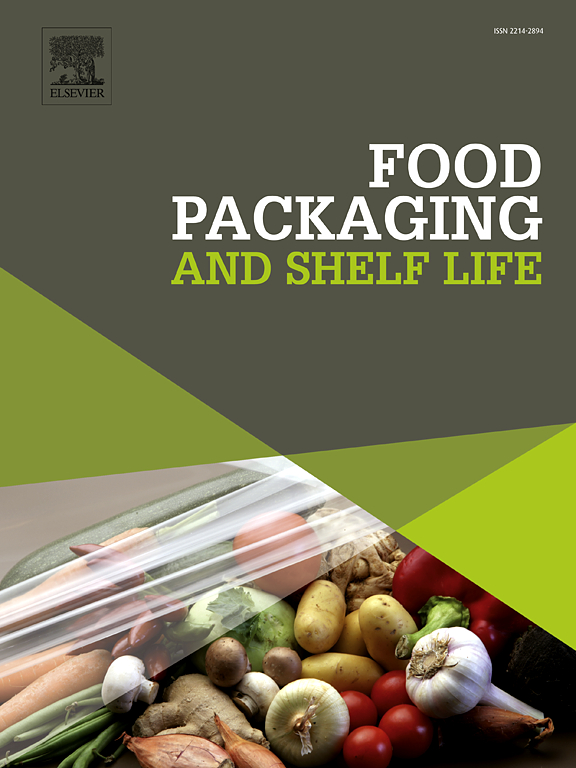Development and characterization of sodium alginate composite films incorporating self-assembled cyclodextrin succinic acid/chitosan nanoparticles encapsulating resveratrol for blueberry preservation
IF 8.5
1区 农林科学
Q1 FOOD SCIENCE & TECHNOLOGY
引用次数: 0
Abstract
Succinate cyclodextrin/chitosan nanoparticles (SCC NPs) loaded with resveratrol (Res) were successfully synthesized by self-assembly. Nanocomposite films were prepared by adding R-SCC NPs to sodium alginate (SA). The structure, physical and chemical properties, and antioxidant, antibacterial and biodegradability properties of the nanocomposite films were characterized. Scanning electron microscopy (SEM) results revealed that R-SCC NPs in 1–6 % were uniformly distributed in the SA film matrix. FTIR analysis revealed that the R-SCC NPs formed intermolecular hydrogen bonds with SA. The maximum tensile strength of the nanocomposite film was 44.24 ± 0.82 MPa, which was 153.50 % of that of the SA film. The addition of R-SCC NPs markedly enhanced the UV absorption capacity, antioxidant stability, and antibacterial activity of the nanocomposite films. In addition, because Res was encapsulated in the SCC NPs, control over the release from the composite film was achieved. This film has excellent biodegradability in soil and can regulate the soil microbial community. Furthermore, the developed film package can effectively prolong the expiry date of blueberries, so the SA film containing R-SCC NPs as active packaging has significant potential for maintaining food quality.
自组装环糊精琥珀酸/壳聚糖纳米颗粒包封白藜芦醇的海藻酸钠复合膜的制备与表征
通过自组装法制备了负载白藜芦醇的琥珀酸环糊精/壳聚糖纳米颗粒。将R-SCC NPs添加到海藻酸钠(SA)中制备纳米复合膜。对纳米复合膜的结构、理化性能、抗氧化、抗菌和生物降解性能进行了表征。扫描电镜(SEM)结果显示,1 ~ 6 %的R-SCC NPs均匀分布在SA膜基质中。FTIR分析表明,R-SCC NPs与SA形成分子间氢键。纳米复合膜的最大抗拉强度为44.24 ± 0.82 MPa,是SA膜的153.50 %。R-SCC NPs的加入显著提高了纳米复合膜的紫外吸收能力、抗氧化稳定性和抗菌活性。此外,由于Res被封装在SCC NPs中,因此可以控制复合膜的释放。该膜在土壤中具有良好的生物降解性,可调节土壤微生物群落。此外,开发的薄膜包装可以有效延长蓝莓的有效期,因此含有R-SCC NPs的SA薄膜作为活性包装具有保持食品质量的巨大潜力。
本文章由计算机程序翻译,如有差异,请以英文原文为准。
求助全文
约1分钟内获得全文
求助全文
来源期刊

Food Packaging and Shelf Life
Agricultural and Biological Sciences-Food Science
CiteScore
14.00
自引率
8.80%
发文量
214
审稿时长
70 days
期刊介绍:
Food packaging is crucial for preserving food integrity throughout the distribution chain. It safeguards against contamination by physical, chemical, and biological agents, ensuring the safety and quality of processed foods. The evolution of novel food packaging, including modified atmosphere and active packaging, has extended shelf life, enhancing convenience for consumers. Shelf life, the duration a perishable item remains suitable for sale, use, or consumption, is intricately linked with food packaging, emphasizing its role in maintaining product quality and safety.
 求助内容:
求助内容: 应助结果提醒方式:
应助结果提醒方式:


